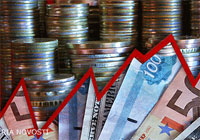Blowing $24 Billion on Ruble Spurs Free-Float Bet

(Bloomberg – bloomberg.com – Vladimir Kuznetsov – October 29, 2014) The ruble’s persistent weakening in the face of $24 billion of interventions is stoking speculation the Bank of Russia will accelerate its switch to a free float.
The currency fell to a record for a sixth day today, losing 0.6 percent to 42.7410 per dollar and bringing this month’s drop to 7.4 percent, the most among 24 developing nations tracked by Bloomberg. The central bank, which plans to stop managing the ruble in 2015, should take the step now to make its interventions less predictable and keep speculators at bay, former Finance Minister Alexei Kudrin said yesterday.
Russia is draining reserves, already at a four-year low, as tumbling oil prices and U.S. and European sanctions over President Vladimir Putin’s role in Ukraine exacerbate the ruble’s losses. While most analysts in a Bloomberg survey expect the central bank to raise interest rates on Oct. 31, policy makers may also loosen the exchange-rate policy, according to Raiffeisen Capital and Commerzbank AG.
“The probability of Kudrin’s scenario being realized is rather high,” Konstantin Artemov, a money manager at Raiffeisen Capital in Moscow, said by e-mail yesterday. “It’s entirely possible that we’ll see 50 rubles per dollar soon.”
Seeking Equilibrium
The central bank sold $21 billion this month through Oct. 27 to slow the ruble’s drop. It poured another $2.8 billion into the market yesterday, Danske Bank A/S analyst Vladimir Miklashevsky said by e-mail, excluding any interventions today.
Kudrin, who was finance minister between 2000 and 2011, said central bank intervention policy gives speculators room to profit since the mechanism is publicly known. When the ruble weakens past the floor of the trading band, the monetary authority spends $350 million to defend it before lowering the boundary by intervals of 5 kopeks, according to its guidelines.
“The exchange rate should always seek equilibrium,” Kudrin said in a phone interview. “And if equilibrium is to be found at a different level, there’s no sense intervening on the way to it. It’s just a waste of reserves.”
Bank of Russia’s press office declined to comment, saying in an e-mail to Bloomberg News yesterday that it’s in a black-out period before the policy meeting. Governor Elvira Nabiullina raised borrowing costs by 250 basis points since March to stem capital outflows as Putin’s standoff over Ukraine escalated. Nineteen out of 28 analysts surveyed by Bloomberg expect a 50 basis point rate rise in two days.
Lehman Experience
Policy makers sold $200 billion in seven months to prop up the ruble after the collapse of Lehman Brothers Holdings Inc. six years ago, slashing reserves by almost 40 percent. They don’t want to “repeat the experience” and may move faster to a free float and inflation targeting, Credit Suisse Group AG said in an Oct. 15 research note.
Currency reserves of the world’s largest energy exporter have fallen $68 billion this year to $443.8 billion on Oct. 17.
Sanctions have shut Russian companies out of international bond and loan markets and created a domestic dollar shortage. With $44 billion in foreign-currency corporate debt due in the last two months of 2014, according to central bank estimates, a speedy depreciation risks increasing the pain for companies.
“A large part of our economy is represented by state companies and state banks, so the central bank can’t just abandon interventions, at least until sanctions are lifted,” Alexander Losev, the chief executive officer of Sputnik Asset Management in Moscow, said by phone yesterday.
‘Fear’ Driven
Investors wary of policy changes “prefer to stack up” foreign-currency holdings, further depressing the ruble, Alexei Egorov, an analyst at OAO Promsvyazbank in Moscow, said by e-mail yesterday.
Russia’s local-currency bonds lost 8.6 percent in dollar terms this month, the most among 31 members in the Bloomberg Emerging Market Local Sovereign Index. The ruble slid 0.7 percent to 47.9988 versus the target dollar-euro basket by 12:51 p.m. in Moscow today.
The exchange rate is “increasingly driven by the fear that the central bank could scrap entirely its defense of the ruble,” Tom Levinson, the chief foreign-exchange and interest-rates strategist at Sberbank CIB, said in an e-mailed note yesterday. Current policy “is also feeding currency weakness by raising concern over the pace at which foreign-currency reserves are being eroded.”
Article ©2014 Bloomberg L.P. All Rights Reserved. Article also appeared at bloomberg.com/news/2014-10-29/blowing-24-billion-on-ruble-spurs-free-float-bet.html
